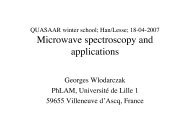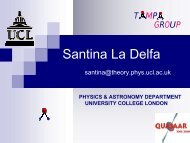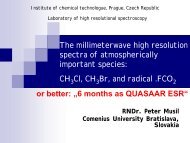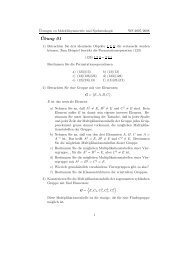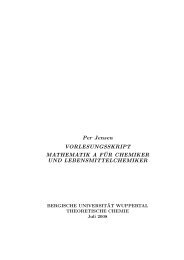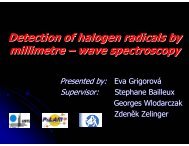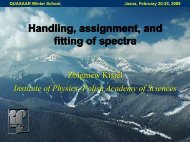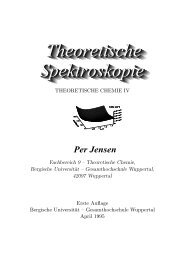140 Poster session, H27Submillimetre-wave spectroscopy of unstable imines of astrophysicalinterest: CH 2 NH and CH 2 CNHClaudio Degli Esposti 1 , Luca Dore 1 , Luca Bizzocchi 21 Dipartimento di Chimica “G. Ciamician”, Università di Bologna,Italy,[claudio.degliesposti , luca.dore]@unibo.it; 2 Centro de Astronomia e Astrofisica,Observaório Astronómico de Lisboa, Portugal, bizzocchi@oal.ul.ptDegli EspostiDore L.Bizzocchi L.Methanimine (CH 2 NH) and ketenimine (CH 2 CNH) are unstable molecules which havebeen detected in different astronomical sources 1,2 . Presently, the published rotationaldata for these species 3,4 are limited to frequency regions which are well below thespectral ranges covered by Herschel/HIFI and the ALMA bands 9 and 10. We haveextended the recordings of rotational lines of CH 2 NH and CH 2 CNH into thesubmillimetre-wave region, in order to improve the precision of ground-state rotationaland centrifugal distortion constants and make it possible to build a list of very accuraterest-frequencies for astrophysical purposes in the THz region (1σ uncertainties lowerthan 0.01 kms −1 in radial equivalent velocity).The investigation was carried out using a source-modulation microwave spectrometerbased on Gunn oscillators equipped with various frequency multipliers. The free-spacecell of the spectrometer was coupled to a high temperature reactor which allowed for theproduction of these species by gas-phase pyrolysis of 1,2 diaminoethane (for CH 2 NH),or isoxazole (for CH 2 CNH). The spectra were recorded in the frequency range 80–630GHz, and many tens of new ground-state transition frequencies were accuratelymeasured for each species. The hyperfine structure due to the 14 N nucleus was veryoften detected, and it was accounted for in the analysis.The complete sets of quartic and sextic centrifugal distortion constants could beaccurately determined for CH 2 NH, while less satisfactory results were obtained forCH 2 CNH, whose ground-state rotational spectrum is perturbed by a centrifugalresonance 5 . Further analyses are currently in progress to achieve a better modeling ofthe observed perturbation.References[1] P. D. Godfrey, R. D. Brown, B. J. Robinson, M. W. Sinclair, Astrophys. Lett., 113,119, 1973[2] F. J. Lovas, J. M. Hollis, A. J. Remijan, P. R. Jewell, ApJ, 645, L137, 2006[3] L. Dore, L. Bizzocchi, C. Degli Esposti, J. Gauss, J. Mol. Spectrosc., 263, 44, 2010[4] M. Rodler, R. D. Brown, P. D. Godfrey, L. M. Tack, Chem. <strong>Ph</strong>ys. Lett., 110, 447,1984[5] M. K. Bane, E. G., Robertson, C. D. Thompson, et al., J. Chem. <strong>Ph</strong>ys., 134, 234306,2011
Poster session, H28 141High signal-to-noise ratio line-shape measurements of the oxygen Bband by PDH-locked FS-CRDSAgata Cygan 1 , Daniel Lisak 1 , Szymon Wójtewicz 1 , Jolanta Domysławska 1 , JosephT. Hodges 2 , Ryszard S. Trawiński 1 , Roman Ciuryło 11 Instytut Fizyki, Uniwersytet Mikołaja Kopernika, Grudziądzka 5/7 87-100, Toruń,Poland, szymon@fizyka.umk.pl; 2 National Institute of Standards and Technology, 100Bureau Drive, Gaithersburg, Maryland 20899, USAWe present an extremely high signal-to-noise ratio measurements of spectral lineshapes. Our Pound-Drever-Hall (PDH) locked frequency-stabilized cavity ring-downspectrometer (FS-CRDS) 1 provides high spectral resolution and low detection limit. Theproblem of unexpected PDH-lock breaking during high-repetition rate ring-down eventsgeneration was solved thanks to an active control of the PDH error signal offset 2 whichassured more reliable and faster work of our spectrometer. Possible extension of laserlight switching-off time, between consecutive ring-down events, up to 1 ms is shown.An exceptionally precise measurements of absorption line shapes are demonstrated onexample of rovibronic transitions of the 16 O 2 B band near λ = 689 nm 3,4 . Obtainedsignal-to-noise ratio of 220000:1 and a minimum detectable absorption coefficient of2.4 × 10 −11 cm −1 corresponds to the lowest line intensity measurable by our setup ofapproximately 1.3 × 10 −30 cm −1 /(molecule cm −2 ) 5 . The detection limit of ourspectrometer was tested on example of weak oxygen line having intensity of 2.716 ×10 −29 cm −1 /(molecule cm −2 ). Careful analysis of the data revealed a subtle line-shapeasymmetry that could be explained by the speed dependence of the collisional shift. Theinfluence of slowly drifting etaloning effects on the precision of the line-shape analysisis presented. The precise line-shape measurements combined with sophisticated dataanalysis are crucial for such experiments as accurate determination of the Boltzmannconstant by optical methods 6,7 .The research is part of the program of the National Laboratory FAMO in Toruń, Poland,and is partially supported by the Foundation for Polish Science TEAM Project cofinancedby the EU European Regional Development Fund. A. Cygan is supported bythe Polish NCN, Project No. N N202 239240.Cygan A.Lisak D.Wojtewicz S.Domyslawska J.Hodges J.T.Trawinski R.S.Ciurylo R.References[1] A. Cygan, D. Lisak, P. Masłowski, K. Bielska, S. Wójtewicz, J. Domysławska, R. S.Trawiński, R. Ciuryło, H. Abe, J. T. Hodges, Rev. Sci. Instrum. 82, 063107 (2011).[2] A. Cygan, D. Lisak, S. Wójtewicz, J. Domysławska, R. S. Trawiński, R. Ciuryło,Meas. Sci. Technol. 22, 115303 (2011).[3] D. Lisak, P. Masłowski, A. Cygan, K. Bielska, S. Wójtewicz, M. Piwiński, J. T.Hodges, R. S. Trawiński, R. Ciuryło, <strong>Ph</strong>ys. Rev. A 81, 042504 (2010).[4] S. Wójtewicz, D. Lisak, A. Cygan, J. Domysławska, R. S. Trawiński, R. Ciuryło,<strong>Ph</strong>ys. Rev. A 84, 032511 (2011).[5] A. Cygan, D. Lisak, S. Wójtewicz, J. Domysławska, J. T. Hodges, R. S. Trawiński,R. Ciuryło, <strong>Ph</strong>ys. Rev. A 85, 022508 (2012).[6] A. Cygan, D. Lisak, R. S. Trawiński, R. Ciuryło, <strong>Ph</strong>ys. Rev. A 82, 032515 (2010).[7] A. Castrillo, M. D. DeVizia, L. Moretti, G. Galzerano, P. Laporta, A. Merlone, L.Gianfrani, <strong>Ph</strong>ys. Rev. A 84, 032510 (2011).
- Page 1 and 2:
Book of abstractsof the 22 th Inter
- Page 3 and 4:
CommitteesLocal Organizing committe
- Page 5:
Table of contentProgram of sessions
- Page 8 and 9:
8 Program of sessionsInvited Lectur
- Page 10 and 11:
10 Program of sessionsD6 Tasinato N
- Page 12 and 13:
12 Program of sessionsD23 Underwood
- Page 14 and 15:
14 Program of sessionsD43 Kirkpatri
- Page 16:
16 Program of sessionsG5 Ebert V. 1
- Page 20 and 21:
20 Program of sessionsH36 Vogt N.,
- Page 22 and 23:
22 Program of sessionsJ8 Tudorie M.
- Page 24 and 25:
24 Program of sessionsJ26 Osman O.,
- Page 26 and 27:
26 Program of sessionsIoannes Marcu
- Page 28 and 29:
28 Program of sessionsContributed L
- Page 31 and 32:
Invited LecturesASeptember 4, Tuesd
- Page 33:
Invited Lectures, A2 33Ultra sensit
- Page 36 and 37:
36 Contributed Lectures, B1Chirped-
- Page 38 and 39:
38 Contributed Lectures, B3Chirped
- Page 40 and 41:
40 Contributed Lectures, B5Laborato
- Page 43 and 44:
Invited LecturesCSeptember 4, Tuesd
- Page 45:
Invited Lectures, C2 45Chiral recog
- Page 48 and 49:
48 Poster session, D1Spectroscopic
- Page 50 and 51:
50 Poster session, D3Ab-initio norm
- Page 52 and 53:
52 Poster session, D5The 2 and 4
- Page 54 and 55:
54 Poster session, D7IR spectroscop
- Page 56 and 57:
56 Poster session, D9The stretching
- Page 58 and 59:
58 Poster session, D11Rotationally-
- Page 60 and 61:
60 Poster session, D13Frequency ana
- Page 62 and 63:
62 Poster session, D15High-L atomic
- Page 64 and 65:
64 Poster session, D17High-Resoluti
- Page 66 and 67:
66 Poster session, D19Frequency-com
- Page 68 and 69:
68 Poster session, D21Variational c
- Page 70 and 71:
70 Poster session, D23Variationally
- Page 72 and 73:
72 Poster session, D25MOGADOC - A D
- Page 74 and 75:
74 Poster session, D27Theoretical I
- Page 76 and 77:
76 Poster session, D29Spectroscopy
- Page 78 and 79:
78 Poster session, D31Coriolis Anal
- Page 80 and 81:
80 Poster session, D33Symmetric gro
- Page 82 and 83:
82 Poster session, D35Dissociative
- Page 84 and 85:
84 Poster session, D37Absorption sp
- Page 86 and 87:
86 Poster session, D39Low-energy vi
- Page 88 and 89:
88 Poster session, D41New progress
- Page 90 and 91: 90 Poster session, D43High Resoluti
- Page 93 and 94: Invited LecturesESeptember 5, Wedne
- Page 95: Invited Lectures, E2 95Theoretical
- Page 98 and 99: 98 Contributed Lectures, F1On the r
- Page 100 and 101: 100 Contributed Lectures, F3High Re
- Page 102 and 103: 102 Contributed Lectures, F5Large A
- Page 105 and 106: Contributed LecturesGSeptember 5, W
- Page 107 and 108: Contributed Lectures, G2 107Inversi
- Page 109 and 110: Contributed Lectures, G4 109Spontan
- Page 111: Contributed Lectures, G6 111High te
- Page 114 and 115: 114 Poster session, H1Computation o
- Page 116 and 117: 116 Poster session, H3Rotationally-
- Page 118 and 119: 118 Poster session, H5The Rotationa
- Page 120 and 121: 120 Poster session, H7Laser-Induced
- Page 122 and 123: 122 Poster session, H9High resoluti
- Page 124 and 125: 124 Poster session, H11Structure, U
- Page 126 and 127: 126 Poster session, H13From succini
- Page 128 and 129: 128 Poster session, H15On the “Ex
- Page 130 and 131: 130 Poster session, H17Hyperfine sp
- Page 132 and 133: 132 Poster session, H19The first ro
- Page 134 and 135: 134 Poster session, H21High Resolut
- Page 136 and 137: 136 Poster session, H23Spectroscopy
- Page 138 and 139: 138 Poster session, H25New investig
- Page 142 and 143: 142 Poster session, H29First analys
- Page 144 and 145: 144 Poster session, H31High-Resolut
- Page 146 and 147: 146 Poster session, H33Rotational s
- Page 148 and 149: 148 Poster session, H35New assignme
- Page 150 and 151: 150 Poster session, H37Hydrogen Sul
- Page 152 and 153: 152 Poster session, H39New Millimet
- Page 154 and 155: 154 Poster session, H41First analys
- Page 156 and 157: 156 Poster session, H43High-Resolut
- Page 159 and 160: Invited LecturesISeptember 6, Thurs
- Page 161: Invited Lectures, I2 161New Telesco
- Page 164 and 165: 164 Poster session, J1Synthesis, Ch
- Page 166 and 167: 166 Poster session, J3Radio Search
- Page 168 and 169: 168 Poster session, J5N 2 -, O 2 -
- Page 170 and 171: 170 Poster session, J7Quantum-class
- Page 172 and 173: 172 Poster session, J9On the ECS fo
- Page 174 and 175: 174 Poster session, J11Measurement
- Page 176 and 177: 176 Poster session, J13Review of th
- Page 178 and 179: 178 Poster session, J15Halogen bond
- Page 180 and 181: 180 Poster session, J17Multispectru
- Page 182 and 183: 182 Poster session, J19Potential en
- Page 184 and 185: 184 Poster session, J21The Study of
- Page 186 and 187: 186 Poster session, J23Pollutants m
- Page 188 and 189: 188 Poster session, J25Preparation
- Page 190 and 191:
190 Poster session, J27Databases of
- Page 192 and 193:
192 Poster session, J29Ozone FTS sp
- Page 194 and 195:
194 Poster session, J31Joint Ro-Vib
- Page 196 and 197:
196 Poster session, J33Water vapor
- Page 198 and 199:
198 Poster session, J35Line positio
- Page 200 and 201:
200 Poster session, J37Hyperfine St
- Page 202 and 203:
202 Poster session, J39Rotational a
- Page 204 and 205:
204 Poster session, J41Tissue Bondi
- Page 207 and 208:
Ioannes Marcus MarciKSeptember 6, T
- Page 209 and 210:
Invited LecturesLSeptember 7, Frida
- Page 211:
Invited Lectures, L2 211Collision-I
- Page 214 and 215:
214 Contributed Lectures, M1Flexibl
- Page 216 and 217:
216 Contributed Lectures, M3Continu
- Page 218 and 219:
218 Contributed Lectures, M5High-pr
- Page 221 and 222:
Contributed LecturesNSeptember 8, S
- Page 223 and 224:
Contributed Lectures, N2 223Two- di
- Page 225 and 226:
Contributed Lectures, N4 225Spectro
- Page 227 and 228:
Contributed Lectures, N6 227Spin-or
- Page 229 and 230:
Contributed Lectures, N8 229Quantum
- Page 231:
Contributed Lectures, N10 231Line m
- Page 234 and 235:
234 Author indexAAbdelghany A. —
- Page 236 and 237:
236 Author indexChoi B. — D33Ciur
- Page 238 and 239:
238 Author indexGGambi A. — D6Gä
- Page 240 and 241:
240 Author indexKhelkhal M. — D29
- Page 242 and 243:
242 Author indexMartin M.A. — D31
- Page 244 and 245:
244 Author indexPolyansky O. — D2
- Page 246 and 247:
246 Author indexSzajna W. — H29,
- Page 248 and 249:
248 Author indexZamotaeva V.A. —
- Page 250 and 251:
250 EmailsAbdelghany A.Abdelghany A
- Page 252 and 253:
252 EmailsGuarnieri A.ag@tf.uni-kie
- Page 254 and 255:
254 EmailsMichaut X.Xavier.Michaut@
- Page 256 and 257:
256 EmailsTyuterev Vl.G.vladimir.ti
- Page 258 and 259:
FT-IR spectrometerIFS 125HROutstand
- Page 260 and 261:
32nd International Symposium on Fre
- Page 262 and 263:
Some more information
- Page 264:
Addresses:Conference Site: National




